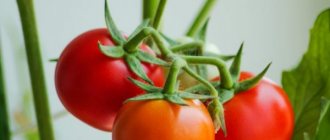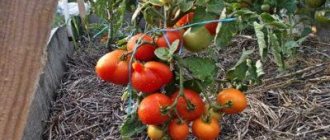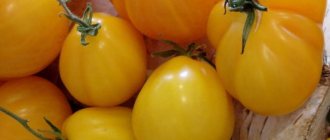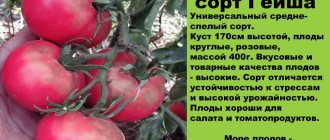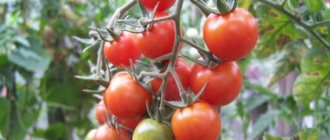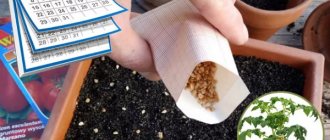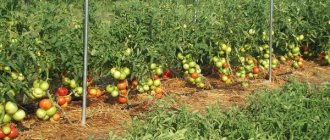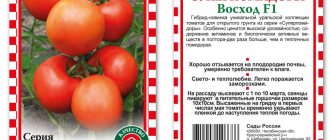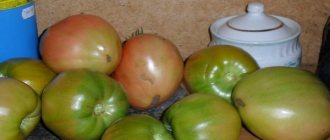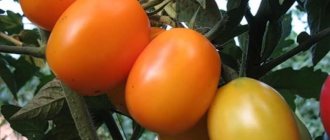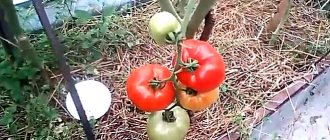What varieties of tomatoes do gardeners prefer? So that there is more harvest, and there is a lot of preparations, and it is not troublesome to grow. An excellent choice is the Parsley Ogorodnik tomato, originally from Altai, but intended for planting throughout the country. The fruits look special and resemble a cap, hence the name.
| Height | Landing location | Ripening time | Fruit color | Fruit size | Origin | Fruit shape |
| Medium height | Greenhouse, Open ground | Mid-early | Reds | Average | Hybrid | Pepper-shaped |
Description and characteristics of the variety
The tomato variety Petrusha Ogorodnik was bred by Altai breeders under the leadership of Dederko and in 2013, having passed all tests, was included in the State Register of Breeding Achievements of Russia.
- This is a hybrid, not a variety.
- Superdeterministic, standard, undersized. In open ground it grows no more than 60 cm in height, in greenhouse conditions it can reach 1-1.2 meters.
- Mid-early ripening period.
- Long-bearing, ripe tomatoes can be harvested from July to October.
- The bush is densely leafy and produces many ovaries.
- The leaves are medium dark green.
- Resistant to blossom end and root rot, late blight, leaf mosaic, as well as other diseases characteristic of this crop.
- Suitable for cultivation in open ground and greenhouses.
Important! To get a larger harvest, gardeners are recommended to grow Parsley tomatoes in open ground. In a greenhouse, this hybrid produces fewer tomatoes.
- The hybrid variety was bred in Siberia, and therefore is suitable for cultivation in all regions of the country, including the northern ones.
- You can improve the taste of tomatoes by limiting the number of flowers and brushes on one bush.
- The density of the bush affects the yield, so it is worth removing the leaves under the flower cluster, this will help redirect the plant juices to the formation of juicy tomatoes.
- The hybrid produces a stable harvest even in dry conditions and does not require frequent watering.
- Productivity is good. 4-6 kg of tomatoes are harvested from 1 bush per season.
- The variety is not picky about pinching; large fruit-bearing clusters with fruits are formed on all shoots through each leaf. Therefore, the gardener himself determines whether to plant stepson or not. But with pinching, the fruits are larger.
- Requires gartering to supports in case of abundant fruiting and the presence of lateral shoots with fruits.
- Abundant and long-lasting fruiting.
- Ripe tomatoes are bright pink.
- The shape is oval, vaguely reminiscent of Parsley's cap.
- The fruits weigh on average 180-200 g, but can grow up to 300 g.
- The pulp is juicy, fleshy, tasty, with a high sugar content.
- The skin is dense but tender.
- Inside there are 6 or more seed chambers containing an average number of seeds.
- They have good keeping quality.
- They withstand long-term transportation well, while maintaining their integrity.
Tomato Parsley gardener: reviews of the variety
Olga Anatolyevna, forty-nine years old, Moscow, the gardener planted tomatoes of the Parsley variety on a summer cottage for the first time. I wanted to try something new and for this purpose I planted one part of the seedlings in a greenhouse, and the second part in open ground. I noticed the differences immediately. The shrubs in the greenhouse did not want to grow for a long time; after growth, inflorescences began to form in the open ground. In terms of harvest quantity, tomatoes in open ground also have noticeably greater advantages. Next year I will absolutely plant this variety of tomatoes in the fresh air.
Aksinya Fedorova, fifty-seven years old, Novosibirsk I simply adore tomatoes, which is why I constantly plant them at the dacha. I usually cultivate tomatoes in the fresh air. I just love it when shrubs don’t require complex agricultural technology and a lot of energy. I no longer have as much strength as before. Having tried a large number of different types of tomatoes, I opted for selective tomatoes, which are intended for cultivation in open ground. I am planting the Parsley tomato variety for the third time. I liked the variety. The vegetable crop does not require much effort, there is no need to trim the foliage and branches growing on the sides, it holds up well in excessive amounts of moisture, and has a high level of disease resistance. Tomatoes are elongated and small in size, which makes them extremely ideal for canning. Vegetables do not lose their shape in the container and do not spread. This variety is well suited for preparing preparations for the winter season.
Svetlana Nikitichna, sixty years old, Perm I cultivate tomatoes in the fresh air and that’s all. I love this method because of its simplicity, ease and clarity. Most tomatoes are considered heat-loving herbaceous plants and require the production of greenhouse factors, so the formation of breeding varieties made me happy. Advantages of the gardener's Parsley tomato: it is small in size, does not need to be pinched and does not need to be processed. In terms of yield and taste, tomatoes cultivated outdoors are no worse than those grown in greenhouses. I love it more from open ground. They ripen faster, are filled with more liquid and are sweetish. Tomatoes for fresh air are just a treasure for a summer resident, helping not to waste a lot of energy and time.
Tomato Parsley gardener: video about the variety
Photo
The following are photos of the tomato variety Parsley Ogorodnik , which show tomatoes on a bush and in cross-section.
Prevention of diseases and pests
The variety is resistant to late blight.
To prevent crown rot (it indicates a lack of calcium), it is recommended to make root dressings from ashes or wood ash. To prepare the working solution, dilute a liter jar of ash in 10 liters of water. You can grind eggshells in a coffee grinder. Powder consumption - 1 tbsp. spoon on a tomato bush.
To prevent diseases it is recommended:
- reduce the density of leaves (cut off the lower leaves after clusters with fruits form);
- regularly ventilate the greenhouse;
- Water the plants in the morning so as not to create additional moisture at night (the moisture will disappear during the day).
It is important to follow the basic principles of crop rotation: alternate where crops are grown. Tomatoes are not planted in one area for several years in a row.
You can scare away pests using folk remedies. The following tinctures work well:
- from garlic. Take 200 g of chopped garlic and leave it in 5 liters of water for several hours. The solution is sprayed onto the above-ground part of the plant;
- from onion skins. For 10 liters of water, take 200 g of onion peels and leave for 10-12 hours. The solution is sprayed onto the bushes.
Advantages and disadvantages
The Parsley gardener tomato has important advantages that distinguish this hybrid from other varieties of tomatoes:
- There is no need to prun the bushes.
- Long-term fruiting.
- Drought resistance, undemanding to watering.
- Resistance to cold weather.
- Not susceptible to most nightshade diseases.
- Easy to care for.
- Universal in use.
Disadvantages include cracking of fruits due to excess moisture. Also, some gardeners complained about the bush’s susceptibility to late blight. However, this is most likely due to violation of agricultural conditions and rainy weather.
Advantages and disadvantages, features, differences from other varieties
There are currently so many varieties and hybrids of tomatoes that when choosing you have to pay attention to all the nuances. Thus, the very fact that the State Register of the Russian Federation says about the Parsley Gardener variety that its fruits have a good taste can be alarming: after all, there are many varieties whose fruit taste is described as excellent. What interested gardeners who think that this variety is very good? It actually has a number of advantages, for example:
- long fruiting;
- drought resistance;
- adaptability to changing weather conditions;
- ease of handling bushes (many gardeners don’t even plant them);
- versatility of using tomatoes;
- good transportability and preservation of the crop;
- interesting appearance of the fruit;
- high disease resistance.
Among the disadvantages, it is especially noteworthy that when grown in greenhouses, the variety requires artificial pollination. However, it is rarely grown in greenhouses: the gardener’s Petrusha’s bushes are not tall, and in greenhouses they try to save every bit of volume and plant those tomatoes that grow to the ceiling and produce more yield per unit area.
Probably, among the Siberian varieties of tomatoes, even the collections of the same breeders, Parsley gardener is not the best. So, for example, if we talk about salad use, it would be worth placing slightly higher the cold-resistant variety Velmozha with fleshy, heart-shaped raspberry fruits of excellent taste.
The nobleman is no less cold-hardy than the gardener Parsley, but its fruits are more tasty
The same authors have an excellent large-fruited salad tomato, Babushkin Secret, the taste of the fruits of which is rated as excellent, and the yield is twice as high as that of Parsley Gardener. However, they prefer to grow Grandma’s secret in film greenhouses. The variety of V.N. Dederko is also an excellent tasting tomato, the Siberian Apple, but it grows in the form of a tall indeterminate bush.
Apparently, a distinctive feature of the Parsley gardener variety is the original shape of the fruit, which, together with the crimson color, is rare. In terms of other parameters, including consumer properties, it is easy to find analogues for this variety.
The main advantages of the Parsley gardener tomato include:
- there is no need to perform pinching;
- fruiting – extended over time;
- the bushes calmly endure the period of drought without reducing the rate of growth and fruiting;
- the collected fruits are distinguished by their universal purpose.
Features of cultivation
The Parsley gardener variety can be grown from cuttings. To do this, take the stepsons and tops of the stems. They are placed in water or damp soil for 10 days. This feature of the variety makes it possible to grow tomatoes for a long time with a minimum number of seedlings, increasing it by light cuttings.
Seeds for seedlings are sown at the end of February or early March. Picking is carried out when 2 full-fledged leaves appear on the seedlings.
Before planting in the ground, seedlings are hardened off for 10-14 days. To do this, the seedlings are taken outside for 15 minutes, gradually increasing the time, bringing the seedlings indoors only at night
Seedlings are planted under film cover at the end of April, in open ground - in May.
Planting scheme – 4-5 bushes per 1 sq. meter. To ensure that tomatoes receive better light during the day, they are placed from north to south. Add 1 tbsp to the prepared wells. spoon of superphosphate or nitrophoska.
The second feeding is carried out 10 days after planting. Complex fertilizers are applied for tomatoes; you can also spray the bushes with a weak solution of potassium permanganate.
More information about growing tomatoes is described in the article: Technology of growing tomatoes. Secrets of planting and care
You might be interested in: How to properly plant tomatoes in a greenhouse: bush formation diagram, care features, photos and videos
Useful information: How to properly tie tomatoes in open ground: the best methods, step-by-step photo and video instructions
Growing rules
Growing tomatoes Parsley gardener consists of performing simple and understandable activities for every summer resident. To get an earlier harvest, you should start by growing strong and healthy seedlings.
The gardener sows Parsley tomato seeds two months before planting them in a permanent place. That is, you need to calculate the time based on your climatic conditions.
The seeds are soaked before sowing. Epin is added to the water if desired. It will speed up germination. Then they are laid out on a damp cloth, covered and left to germinate. The seeds should hatch within two or three days.
Sprouted seeds are planted in prepared containers: boxes, peat pots, or other containers. Before planting, it is advisable to spill the soil with a solution of Fitosporin. It will destroy pathogens.
There is another way to plant seeds. Some housewives sow them dry. Mulch with loose, light soil. The container is covered with cloth. Snow is placed on top of it, as much as it fits. Leave in a warm place until germination. Snow is reported if necessary. It melts slowly, evenly wetting the soil. The fabric prevents the soil from compacting and settling.
As soon as the shoots appear, the fabric is removed and the containers with seedlings are transferred to a well-lit place. After the second true leaf grows, the plants dive. According to the description of summer residents, the gardener's Parsley tomato seedlings do not stretch. It is formed strong, short, with a powerful stem.
10 days before planting in open ground, the plants are hardened off. For this purpose, place it on the balcony or open the windows. Subsequently, you can take the boxes with seedlings outside or onto the veranda. It is not advisable to leave young plants in a draft and in a bright sunny place - find a shaded place for them, protected from the piercing wind.
Application
Tomatoes of the Parsley gardener variety have a pronounced tomato taste, so they are recommended to be consumed fresh and added to salads. They are also suitable for canning and making juices. It is not possible to preserve whole tomatoes due to their size, but they can be used to make lecho, adjika, and tomato paste. The sweet juice of Gardener's Parsley is suitable for canning other varieties in tomato juice.
Watch the video! Tomato Parsley gardener
Bush care
Recommendations for further planting care:
- Application of organic fertilizers. Two weeks after planting, root feeding is carried out with an infusion of slurry. To prepare the fertilizer, dilute manure and water in equal proportions and leave to infuse for 2-3 days. Then add water 10 times the amount and water the bushes. To prepare an infusion, chicken manure is diluted in a ratio of 1:20. During the season, 2-3 feedings are carried out;
- With the help of pinching, you can significantly improve the taste of the fruit. However, whether to carry it out or not depends on the decision of the gardener;
- The soil near the seedlings needs regular loosening and hilling. Mulched soil retains moisture better and suppresses the growth of weeds. Straw or freshly cut grass is used as mulch;
- Regular watering. Warm water is used for irrigation. Water only in the morning, avoiding dripping on the foliage.
When transplanting seedlings to a permanent place, superphosphate or nitrophoska is added to each bush (no more than a tablespoon in each hole). Further care for growing bushes consists of regular watering, fertilizing, loosening the soil and removing weeds.
Tomato bushes need to be watered regularly, not allowing the soil to dry out. Although the Parsley Gardener variety, according to experts, calmly tolerates periods of drought, it is better not to allow the soil in the beds to dry out regularly, otherwise the fruits will grow less juicy and tasty.
Water for irrigation should be settled and warm. The watering schedule in hot and dry summers is once every 2-3 days. If the summer is rainy, then watering is carried out according to the situation.
Very few stepsons are formed on these standard bushes, so vegetable growers do not have to carry out the stepsoning procedure regularly.
The shoots of the Parsley gardener tomato are not tall, but strong and powerful; they can easily withstand the weight of the ripening harvest, do not break under its weight, and therefore do not require garter.
Garter of tomatoes
As a result, caring for this variety is easier and requires less time than for tall varieties of tomatoes.
Fertilizers should be applied to tomato bushes regularly. After planting the seedlings in the beds, the next time you should feed them is 12-14 days later.
Complex fertilizer for vegetable crops is used as fertilizer. Feeding “by leaf” with a weak solution of potassium permanganate also gives a good effect.
To obtain a good harvest, it is necessary to apply fertilizers every 12-14 days, alternating the application of mineral fertilizers and organic matter. Many summer residents apply a solution of cow manure or bird droppings under the bushes.
In greenhouses, the bushes of this tomato grow much larger than in open ground. The principles of growing this mid-early tomato in closed ground conditions do not differ from planting and growing similar varieties of tomatoes.
